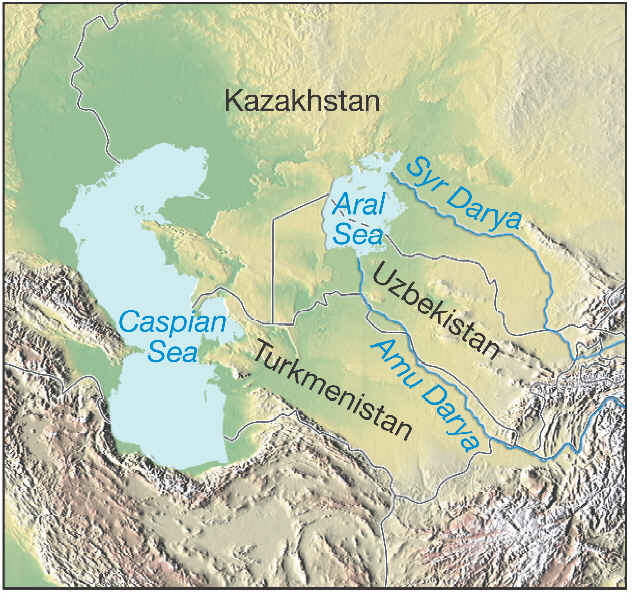Aral Sea
THE ARAL SEA (Aral'skoye More) is one of the world's largest lakes or inland seas. It is located to the east of the CASPIAN SEA in the Central Asian republics of Kazakhstan and Uzbekistan. The region is arid, with the Karakum Desert lying to the west of the Aral Sea and the Kyzylkum Desert to the east. The sea is shallow with no outlet; the water level is determined by the balance between loss from evaporation, input from rivers, groundwater, and precipitation. Its main source of water is two rivers: the Syr Darya (the ancient River Jaxartes) and the AMU DARYA (the ancient River Oxus), which rise in the foothills of the northern HIMALAYAN mountains.
During the last 3 million years, the lake has periodically flooded and experienced episodes of desiccation as the Earth has cooled and warmed. Recent changes are, however, the result of human activity, and the sea now has a negative water balance; that is, there is a net loss of water annually. This is mainly because the Amu Darya and Syr Darya are subject to considerable water extraction for irrigation. Consequently, the Aral Sea has shrunk in size, especially in the last 70 years as cotton production in Central Asia has intensified. Even in the last 40 years, the area of the Aral Sea has decreased by about 50 percent and its level has dropped by more than 56 ft (17 m). Almost 19.8 million acres (8 million hectares) of land in the region are now under irrigation, compared with only 7.4 million acres (2.9 million hectares) in 1900 and 12.4 million acres (5 million hectares) in 1960. Moreover, much irrigation is inefficient as water loss from the canal network is high through exposure of a large surface area of water that encourages evaporation. The Aral Sea is no longer one water body; its volume has decreased by two-thirds and since 2001 there have been three water bodies. The shoreline has decreased by 300 mi (480 km), isolating settlements from the water's edge in salt desert.

Water quality has also altered as salinity and mineral content have increased, and wind-blown sediment is a problem. Fish and wildlife losses have ensued and no commercial fishing is possible; vegetation cover has diminished as fewer species can tolerate the harsh environment. Livelihoods based on fishing and hunting have disappeared.
Human health problems have also developed, partly because of poor water quality attributed to contamination with agricultural chemicals. Average life expectancy is only about 40 years, the rate of infant mortality is three to eight times higher than that in the United States, and rates of miscarriage are high, as are incidences of viral hepatitis and tuberculosis. Inevitably, there is rapid depopulation because of these adverse conditions. Since the demise of the Soviet Union, cotton production has declined but without much difference in water extraction. The outlook is not encouraging. The exploitation of oil and gas reserves in the region may exacerbate an already acute environmental situation.